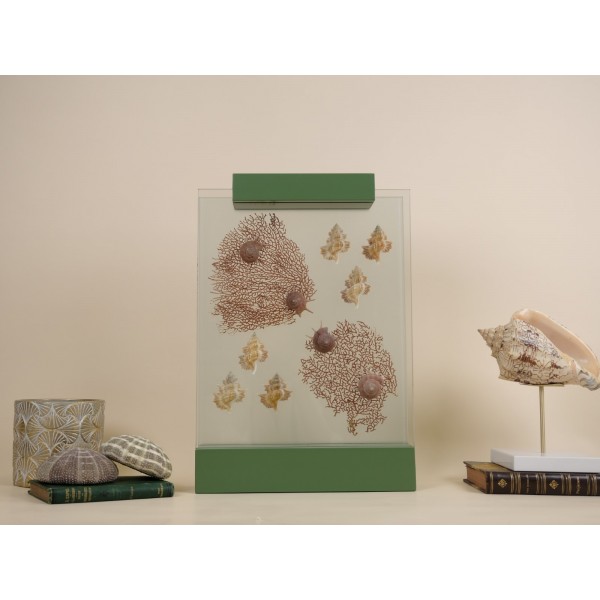Sponge sp.
Fantastic deep water Sponge species. A deep water hard sponge, very peculiar resemble Turbinaria coral.
Mounted in a black lacquered wood base, from Tulear, Madagascar waters.
| close |
This shop uses cookies to improve your experience on our website. |
Reference: N557
Marine life in an open vitrine with green lacquered wood, comprising six specimen of Biplex perca big size, from South China Sea and four Guildfordia triumphans also from South China Sea on two beautiful Orange Gorgonia from Philippines.
A One of a Kind handmade piece.
Dimensions: 43,5 cm x 30 cm x 8 cm
Weight: 4,2 Kg

Marine life in an open vitrine with green lacquered wood, comprising six specimen of Biplex perca big size, from South China Sea and four Guildfordia triumphans also from South China Sea on two beautiful Orange Gorgonia from Philippines.
A One of a Kind handmade piece.
Fantastic deep water Sponge species. A deep water hard sponge, very peculiar resemble Turbinaria coral.
Mounted in a black lacquered wood base, from Tulear, Madagascar waters.
Tridacna gigas (Linnaeus, 1758)
Beautiful and very perfect resin replica in big size of this elusive piece protected nowadays.
It can be used as a decor piece, ice bucket or just for display!
A beautiful Shell ball made with Cerithiidae shells, from Indonesia.
These balls are part of the Indo-Pacific cultural heritage, and from a long time tribal people use them as adornment pieces. Today they are natural and beautiful decor pieces.
Nautilus pompilius - nowadays is a protected specimen, this is why it is supplied with CITES.
This is a great chance to get one!
Glass dome with two beautiful Stellaria solaris and three Spondylus variegatus, from Philippines deep water.
This stunning Victorian-style table tray features two large valves of Pecten subnodosus, a species of scallop commonly known as the Giant Lion's Paw. Native to the Pacific and Gulf of California coasts of the Baja California Peninsula, Mexico, extending southward to the western coast of Peru. These specimens originate from Baja California, USA. This species is edible.
Mounted in a Victorian style with one Carnelian cabochon and four Amethyst cabochons, all set in a handmade dark brass base.
This species of Spongia came from the Florida Keys.
It is a very healthy population once from many years they are fished commercially for bath sponges, these are special pieces turned into great decor objects. The sponges feed on microorganisms that they filter and their larvae are taken by the sea movements making them widespread. Taken by divers from 5 to 40 meters deep.
Mounted in a black lacquered wood stand.
An exceptional Spondylus visayensis in a glass dome.
This is a Museum class specimen with 130mm diameter, taken twenty-five years ago by the late E. Guillot de Suduiraut and in our collection since that.
A rare masterpiece of nature.
A beautiful glass dome with 7 Epitonium scalare and a few small corals.
Epitonium scalare is a classic elusive species, from Philippines.
Beautiful Hexaplex nigritus from Mexico, always a very elusive shell, make a curious decor item.
Mounted in a brass and white lacquered wood base.
A spectacular Spondylus variegatus attached in a Malleus malleus shell from Davao - Philippines, in a white lacquered wood pedestal.
The Spondylus is a marine bivalve from the Spondilidae family, perfectly preserved. The Malleus malleus shell a marine bivalve mollusk in the family Malleidae, it is also known as the black hammer oyster.
This is a uncommon attachment that came out by divers from time to time.
The two shells live in perfect symbiosis.
Marine life glass dome composed by: small Gorgonia from de Indo-Pacific, one coral Montipora sp., two Fusinus colus, one Fusinus undatus from Balicasag - Philippines, three Mitra mitra from Punta Engaño - Philippines and one beautiful Xenophora pallidula from deep water of Davao - Philippines.
Also three white sea stars and one sea bisquit all from Caribbean Sea.
One of a Kind handmade piece!
Sponge species from Madagascar reefs, mounted in a black lacquered wood base.
Sponges are beautiful decor items, due to its different shapes and colours.
Marine Life glass dome with a Yellow hardhead sponge from Florida - USA, a big Scottish Sea urchin from North Sea - UK, Metalia sternalis from Mactan Islands - Philippines, Bolma girgyllus from Palawan Islands. - Philippines and Pocillopora eydouxi from Solomon Islands.
Beautiful colorful decor piece.
An exceptional specimen of pinna nobilis, from Greece, in a black lacquered wood frame .
The specimen came from a old collection, today is impossible to get this size specimen.
One of a Kind decor piece!
Spondylus usually attach themselves to rocks, corals, anything from time to time we found some surprising attachments, here we have a beautiful Sopndylus echinatus, from Philippines, attached in a black gorgonia trunk, making this piece very special.
Mounted in an acrylic base.